中国饮食文化和翻译
- 格式:ppt
- 大小:6.79 MB
- 文档页数:30
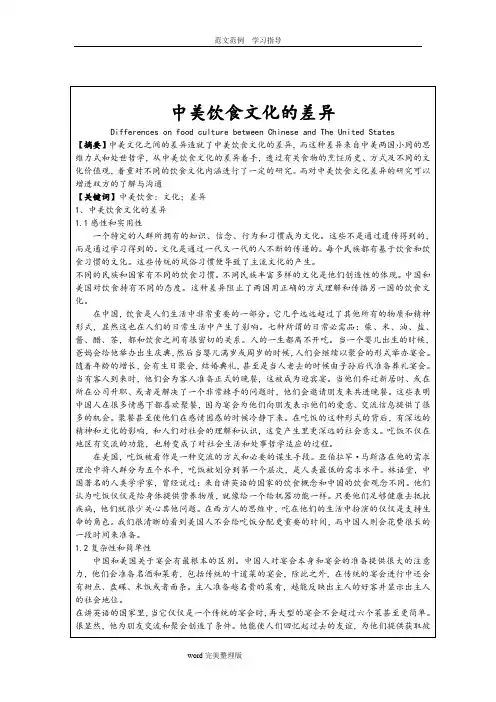
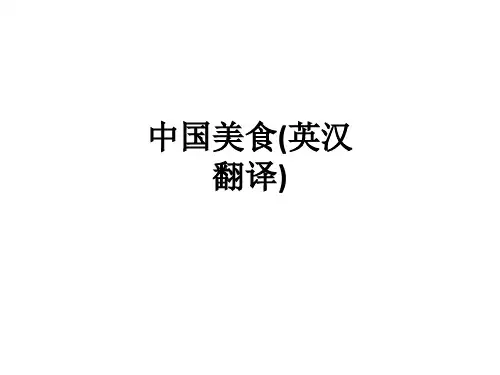

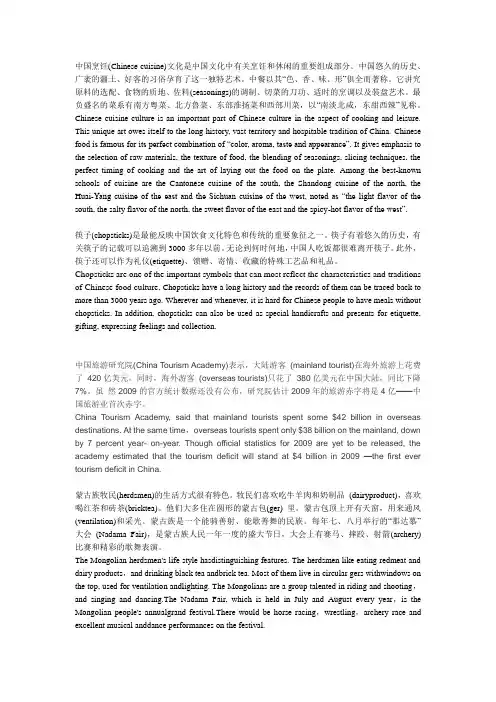
中国烹饪(Chinese cuisine)文化是中国文化中有关烹饪和休闲的重要组成部分。
中国悠久的历史、广袤的疆土、好客的习俗孕育了这一独特艺术。
中餐以其“色、香、味、形”俱全而著称。
它讲究原料的选配、食物的质地、佐料(seasonings)的调制、切菜的刀功、适时的烹调以及装盘艺术。
最负盛名的菜系有南方粤菜、北方鲁菜、东部淮扬菜和西部川菜,以“南淡北咸,东甜西辣”见称。
Chinese cuisine culture is an important part of Chinese culture in the aspect of cooking and leisure. This unique art owes itself to the long history, vast territory and hospitable tradition of China. Chinese food is famous for its perfect combination of “color, aroma, taste and appearance”. It gives emphasis to the selection of raw materials, the texture of food, the blending of seasonings, slicing techniques, the perfect timing of cooking and the art of laying out the food on the plate. Among the best-known schools of cuisine are the Cantonese cuisine of the south, the Shandong cuisine of the north, the Huai-Yang cuisine of the east and the Sichuan cuisine of the west, noted as “the light flavor of the south, the salty flavor of the north, the sweet flavor of the east and the spicy-hot flavor of the west”.筷子(chopsticks)是最能反映中国饮食文化特色和传统的重要象征之一。
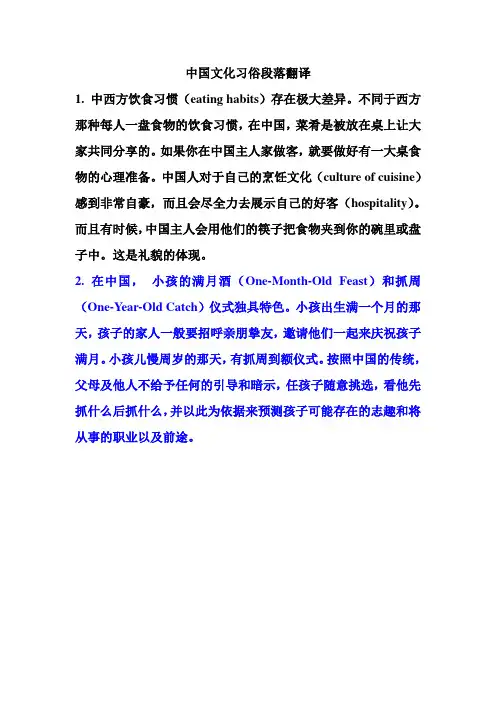
中国文化习俗段落翻译1. 中西方饮食习惯(eating habits)存在极大差异。
不同于西方那种每人一盘食物的饮食习惯,在中国,菜肴是被放在桌上让大家共同分享的。
如果你在中国主人家做客,就要做好有一大桌食物的心理准备。
中国人对于自己的烹饪文化(culture of cuisine)感到非常自豪,而且会尽全力去展示自己的好客(hospitality)。
而且有时候,中国主人会用他们的筷子把食物夹到你的碗里或盘子中。
这是礼貌的体现。
2. 在中国,小孩的满月酒(One-Month-Old Feast)和抓周(One-Year-Old Catch)仪式独具特色。
小孩出生满一个月的那天,孩子的家人一般要招呼亲朋挚友,邀请他们一起来庆祝孩子满月。
小孩儿慢周岁的那天,有抓周到额仪式。
按照中国的传统,父母及他人不给予任何的引导和暗示,任孩子随意挑选,看他先抓什么后抓什么,并以此为依据来预测孩子可能存在的志趣和将从事的职业以及前途。
参考译文1.There are great differences between Chinese and Western eating habits. Unlike the West, where everyone has their own plate of food, in China the dishes are placed on the table and everybody shares. If you are being treated by a Chinese host, be prepared for a table of food. Chinese are very proud of their culture of cuisine and will do their best to show their hospitality. And sometimes the Chinese hosts use their chopsticks to put food in your bowl or plate. This is a sign of politeness.参考译文2: In China, One-Month-Old Feast and One-Year-Old Catch of a baby are of unique Chinese characteristics. On the day when a baby is a month old, the family of the baby will invite their friends and relatives to a ceremony to celebrate the occasion. On the day when a baby is one year old, there is a ceremony of One-Year-Old Catch. According to Chinese traditional custom, nobody will give any instruction or clue to the baby so that it is left free to choose by itself. Watching the baby catch the articles it likes, the family can then make predictions about its potential interest, future career and development.春节贴年画(pasting New Year Print s)的风俗源自于往房子外面的门上贴门神(Door Gods)的传统,随着木质雕刻品(board carvings)的出现,年画包含了更广泛地主题,最出名的就是门神,三大神——福神、薪神、和兽神(three Gods of Blessings, Salary and Longevity),寓意着庄稼丰收、家畜兴旺和庆祝春节。
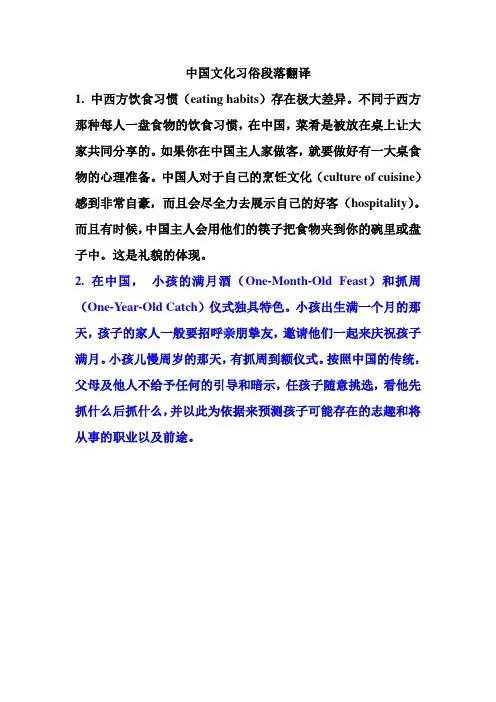
中国文化习俗段落翻译1. 中西方饮食习惯(eating habits)存在极大差异。
不同于西方那种每人一盘食物的饮食习惯,在中国,菜肴是被放在桌上让大家共同分享的。
如果你在中国主人家做客,就要做好有一大桌食物的心理准备。
中国人对于自己的烹饪文化(culture of cuisine)感到非常自豪,而且会尽全力去展示自己的好客(hospitality)。
而且有时候,中国主人会用他们的筷子把食物夹到你的碗里或盘子中。
这是礼貌的体现。
2. 在中国,小孩的满月酒(One-Month-Old Feast)和抓周(One-Year-Old Catch)仪式独具特色。
小孩出生满一个月的那天,孩子的家人一般要招呼亲朋挚友,邀请他们一起来庆祝孩子满月。
小孩儿慢周岁的那天,有抓周到额仪式。
按照中国的传统,父母及他人不给予任何的引导和暗示,任孩子随意挑选,看他先抓什么后抓什么,并以此为依据来预测孩子可能存在的志趣和将从事的职业以及前途。
参考译文1.There are great differences between Chinese and Western eating habits. Unlike the West, where everyone has their own plate of food, in China the dishes are placed on the table and everybody shares. If you are being treated by a Chinese host, be prepared for a table of food. Chinese are very proud of their culture of cuisine and will do their best to show their hospitality. And sometimes the Chinese hosts use their chopsticks to put food in your bowl or plate. This is a sign of politeness.参考译文2: In China, One-Month-Old Feast and One-Year-Old Catch of a baby are of unique Chinese characteristics. On the day when a baby is a month old, the family of the baby will invite their friends and relatives to a ceremony to celebrate the occasion. On the day when a baby is one year old, there is a ceremony of One-Year-Old Catch. According to Chinese traditional custom, nobody will give any instruction or clue to the baby so that it is left free to choose by itself. Watching the baby catch the articles it likes, the family can then make predictions about its potential interest, future career and development.春节贴年画(pasting New Year Print s)的风俗源自于往房子外面的门上贴门神(Door Gods)的传统,随着木质雕刻品(board carvings)的出现,年画包含了更广泛地主题,最出名的就是门神,三大神——福神、薪神、和兽神(three Gods of Blessings, Salary and Longevity),寓意着庄稼丰收、家畜兴旺和庆祝春节。
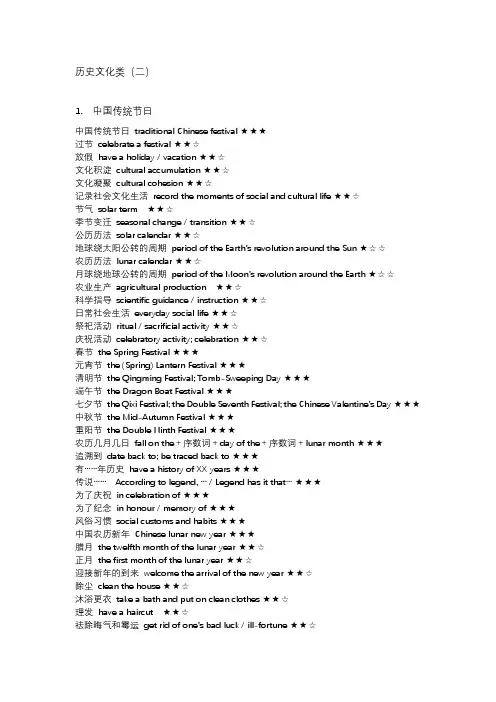
历史文化类(二)1. 中国传统节日中国传统节日traditional Chinese festival ★★★过节celebrate a festival ★★☆放假have a holiday / vacation ★★☆文化积淀cultural accumulation ★★☆文化凝聚cultural cohesion ★★☆记录社会文化生活record the moments of social and cultural life ★★☆节气solar term ★★☆季节变迁seasonal change / transition ★★☆公历历法solar calendar ★★☆地球绕太阳公转的周期period of the Earth’s revolution around the Sun ★☆☆农历历法lunar calendar ★★☆月球绕地球公转的周期period of the Moon’s revolution around the Earth ★☆☆农业生产agricultural product ion ★★☆科学指导scientific guidance / instruction ★★☆日常社会生活everyday social life ★★☆祭祀活动ritual / sacrificial activity ★★☆庆祝活动celebratory activity; celebration ★★☆春节the Spring Festival ★★★元宵节the (Spring) Lantern Festival ★★★清明节the Qingming Festival; Tomb-Sweeping Day ★★★端午节the Dragon Boat Festival ★★★七夕节the Qixi Festival; the Double Seventh Festival; the Chinese Valentine’s Day ★★★ 中秋节the Mid-Autumn Festival ★★★重阳节the Double Ninth Festival ★★★农历几月几日fall on the+序数词+day of the+序数词+luna r month ★★★追溯到date back to; be traced back to ★★★有……年历史have a history of XX years ★★★传说……According to legend, … / Legend has it that… ★★★为了庆祝in celebration of ★★★为了纪念in honour / memory of ★★★风俗习惯social customs and habits ★★★中国农历新年Chinese lunar new year ★★★腊月the twelfth month of the lunar year ★★☆正月the first month of the lunar year ★★☆迎接新年的到来welcome the arrival of the new year ★★☆除尘clean the house ★★☆沐浴更衣take a bath and put on clean clothes ★★☆理发have a haircut ★★☆祛除晦气和霉运get rid of one’s bad luck / ill-fortune ★★☆置办年货purchase necessities for the new year ★★☆招待亲朋好友entertain relatives and friends ★★☆烘托节日的气氛add an air of festivity ★★☆大年三十Chinese New Year’s Eve ★★★贴春联paste Spring Festival couplets ★★☆贴“福”字paste the Chinese character “Fu” ★★☆贴窗花paste window paper-cuts ★★☆吃团圆年夜饭have New Year Eve reunion dinner ★★☆看春晚watch the Spring Festival Gala ★★☆燃放烟花爆竹set off fireworks and firecrackers ★★☆辞旧迎新ring out the Old Year; ring in the New Ye ar ★★☆正月初一the first day of the lunar new year ★★★穿上新衣新鞋put on new clothes and shoes ★★☆祈求新的开始pray for a new beginning in life ★★☆新年贺礼New Year gifts / presents ★★☆走亲访友visit / call on relatives and friends ★★☆给……拜年give sb. New Year greetings ★★☆红包red packet / envelope ★★★压岁钱money given to children as a New Year gift ★★☆好运good luck / fortune ★★★长寿longevity ★★★ 幸福happiness ★★★喜庆场合festive occasion ★★☆灯会lantern show / exhibition ★★☆赏花灯appreciate colourful lanterns ★★☆猜灯谜guess lantern riddles ★★☆观看舞龙舞狮表演watch the dragon-lion dance performances ★★☆悠久历史文化time-honoured history and culture ★★★精神文化遗产spiritual and cultural heritage ★★☆全球化飞速发展的今天in this rapidly globalizing world ★★☆西方文化思想Western cultures and thoughts ★★☆过洋节celebrate the Western festivals ★★☆传统节日的传承inheritance of traditional festivals ★★☆弘扬中国传统文化carry forward traditional Chinese culture ★★☆传承中华传统美德inherit the traditional virtues of the Chinese nation ★★☆ 增强民族凝聚力e nhance / strengthen national cohesion ★★☆2. 中国饮食文化饮食文化food culture ★★★春卷Chinese spring roll ★☆☆汤圆tangyuan (sweet rice dumpling) ★☆☆青团qingtuan (sweet green rice ball) ★☆☆粽子zongzi (Chinese rice-pudding) ★★★月饼mooncake ★★★重阳糕Double-Ninth cake ★☆☆饮食习惯eating / dietary habits ★★★主食staple food ★★☆大米/水稻rice ★★★馒头steamed bun ★★★面条noodles ★★★农作物crop ★★★小麦wheat ★★★副食non-staple / subsidiary food ★★☆鸡肉chicken ★★★鸭肉duck ★★★鱼肉fish ★★★水果fruit ★★★蔬菜vegetable ★★★维持均衡的膳食maintain a well-balanced diet ★★☆摄取所需的营养obtain adequate nourishment ★★☆确保健康secure physical health ★★☆避免疾病avoid / prevent diseases ★★☆传统待客之道traditional hospitality ★★★菜品种类丰富a rich / wide variety of dishes ★★☆宴席feast / banquet ★★★凉菜cold dish ★★★开胃菜appetizer ★★☆味蕾taste bud ★★☆主菜main course ★★★热菜hot dish ★★★肉类meat ★★★家禽poultry ★★★海鲜seafood ★★★时蔬seasonal vegetable ★★★甜点dessert ★★★清淡食物light food ★★☆解油腻get rid of the greasy feeling after eating fatty / oily food ★☆☆ 助消化help / facilitate digestion ★★☆食材ingredient ★★☆烹饪风格cooking style ★★★菜系cuisine ★★★家乡菜hometown dish ★★☆八大菜系China’s 8 major regional cuisines ★★☆川菜Sichuan cuisine ★★☆鲁菜Sh andong cuisine ★★☆粤菜Cantonese cuisine ★★☆苏菜Jiangsu cuisine ★★☆浙菜Zhejiang cuisine ★★☆闽菜Fujian cuisine ★★☆湘菜Hunan cuisine ★★☆徽菜Anhui cuisine ★★☆特色菜speciality ★★☆色、香、味俱全a perfect combination of appearance, aroma and flavour ★★☆ 酸sour ★★☆甜sweet ★★☆苦bitter ★★☆辣spicy ★★☆咸salty ★★☆大厨chef ★★☆佐料seasoning ★★☆柴firewood ★★☆米rice ★★☆油cooking oil ★★☆盐salt ★★☆酱sauce ★★☆醋vinegar ★★☆茶tea ★★☆神农氏Shennong ★☆☆尝百草taste hundreds of herbs ★☆☆解毒clear away toxic materials; get rid of the poisoning effect ★☆☆茶馆teahouse ★★☆茶树tea tree ★★☆种植在山上plant on hills ★★☆茶叶的质量quality of tea leaves ★★☆得名于get name because… ★★☆浓郁strong ★★☆持久long-lasting ★★☆清淡faint ★★☆香甜sweet ★★☆唇齿留香f eel the flavour in mouth / on lips for a long time ★★☆修身养性cultivate moral characters ★★☆陶冶情操cultivate sentiments ★★☆去除杂念remove distracting thoughts ★★☆【补充词汇】1. 二十四节气立春spring begins ★☆☆雨水more rain than snow ★☆☆惊蛰hibernating insects awake n ★☆☆春分spring center ★☆☆清明clear and bright ★☆☆谷雨wheat rain ★☆☆立夏summer begins ★☆☆小满creatures plentish ★☆☆芒种seeding millet ★☆☆夏至summer maximum (solstice) ★☆☆小暑a bit sweltering ★☆☆大暑most sweltering ★☆☆立秋autumn begins ★☆☆处暑heat withdraws ★☆☆白露dews ★☆☆秋分autumn center ★☆☆寒露cold dews ★☆☆霜降frost ★☆☆立冬winter begins ★☆☆小雪snows a bit ★☆☆大雪snows a lot ★☆☆冬至winter maximum ★☆☆小寒a bit frigid ★☆☆大寒most frigid ★☆☆2. 中国传统节日黄金周golden week ★★★国家法定假日official national holiday ★★★烧香burning incense ★☆☆纸钱joss paper ★☆☆祭祖宗offer sacrifices to one’s ancestors ★★☆ 孔明灯Kongming lantern ★☆☆子孙后代offspring ★★☆纪念碑memorial tablet ★☆☆悼文memorial essay ★☆☆网上祭扫online tomb-sweeping ★★☆扫墓sweep tombs ★★☆扫墓者tomb sweeper ★★☆踏青spring outing ★★☆绿柳green willow ★★☆伟大的爱国诗人great patriotic poet ★★☆楚国the state of Chu ★★☆爱国主义patriotism ★★☆奉献精神dedication ★★☆不朽的著作immortal masterpiece ★★☆赛龙舟dragon-boat racing ★★★带香囊wear perfu med medicine bags ★☆☆鹊桥the bridge of magpies ★☆☆王母娘娘Goddess of Heaven ★☆☆银河the Milky Way ★★☆庆祝丰收celebrate harvest ★★☆拜月worship the moon ★★☆赏月enjoy the moon’s beauty; appreciate the full moon ★★☆合家团聚family reunion ★★★嫦娥奔月Chang’e Flying to the Moon ★☆☆登高/爬山mountain climbing ★★☆去除厄运dispel bad luck ★★☆去除恶灵dispel evil spirits ★★☆带来好运bring good fortune ★★★尊敬老人show respect for elders ★★★3. 中国饮食文化谷物grain ★★★面粉flour ★★☆面包bread ★★★糕点pastry ★★☆小吃snack ★★★菜谱recipe ★★☆菜单menu ★★★全鱼the whole fish ★★★汤soup ★★★美食家gourmet ★★☆餐具tableware ★★☆菜肴的装盘和摆放the layout and design of the dishes ★★☆ 佐料的搭配the blending of seasoning ★★☆调味的艺术the art of proper seasoning ★★☆烹饪艺术culinary art ★★☆煮boil ★★☆清蒸steam ★★☆ 清炒plain-fry ★☆☆油炸deep-fry ★☆☆ 烘培roast ★★☆刀工slicing technique ★☆☆烹饪餐具cooking utensil ★★☆饮料beverage ★★☆茶具tea set ★★☆茶壶teapot ★★☆茶杯teacup ★★☆茶托saucer ★★☆紫砂purple sand ★☆☆陶器pottery ★★☆瓷器porcelain ★★☆茶道tea ce remony ★☆☆食疗Chinese food therapy ★★☆食补保健maintain good health through the intake of nourishing food ★★☆4. 其它文化类词汇文化多样性cultural diversity ★★★多元文化社会multicultural society ★★★跨文化交流cross-cultural communication ★★★文化交流与合作cultural exchange and cooperation ★★★文化繁荣cultural prosperity ★★★东方文化Eastern / Oriental culture ★★★民俗文化folk culture ★★☆传统意识形态traditional ideology ★★☆丰富文化生活enrich cultural life ★★☆中国结Chinese knot ★★☆手工艺handicrafts ★★☆手工艺人handicraftsman ★★☆祈求好运pray for good luck ★★☆辟邪ward off evil spirits ★★☆中医traditional Chinese medicine ★★★针灸acupuncture ★☆☆穴位acupuncture point ★☆☆推拿medical massage ★☆☆拔火罐疗法cupping therapy ★☆☆理疗physical therapy ★☆☆医疗保健health care ★★★心heart ★★☆肝liver ★★☆脾spleen ★★☆胃stomach ★★☆肺lung ★★☆肾kidney ★★☆中草药Chinese herbal medicine ★★☆副作用side effect ★★☆切脉feel the pulse ★☆☆偏方folk prescription ★☆☆秘方secret prescription ★☆☆传统中国画traditional Chinese painting ★★★饮茶下棋drink tea and play chess ★★☆耕耘收割plough and harvest ★★☆织布缝衣weave and sew ★★☆砍柴采药cut firewood and gather herbs ★★☆吟诗作画compose poems and draw pictures ★★☆中国书画Chinese painting and calligraphy ★★★山水画Chinese landscape painting ★☆☆水墨画Chines e ink and wash painting ★☆☆汉字Chinese character ★★★文房四宝the four treasures of the Chinese study ★★☆ 笔墨纸砚brush, ink, paper and ink stone ★★☆中国传统体育运动traditional Chinese sports ★★★功夫/武术kung fu; Chinese martial arts ★★★自卫self-defence ★★☆国宝nation al treasure ★★☆太极拳Tai Chi; shadow boxing ★★★中国传统服饰traditional Chinese costume ★★★民族服饰national costume ★★★宽松长袍loose robe ★★☆女性美women’s beauty ★★☆时装秀fashion show ★★☆社交聚会social gathering ★★☆中国民乐Chinese folk music ★★☆乐器musical instrument ★★☆中国传统戏曲traditional Chinese opera ★★☆中国生肖Chinese zodiac ★★☆。
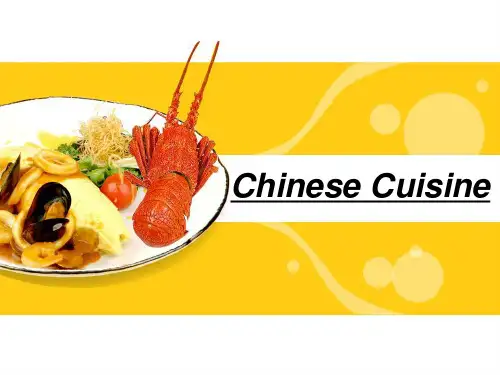
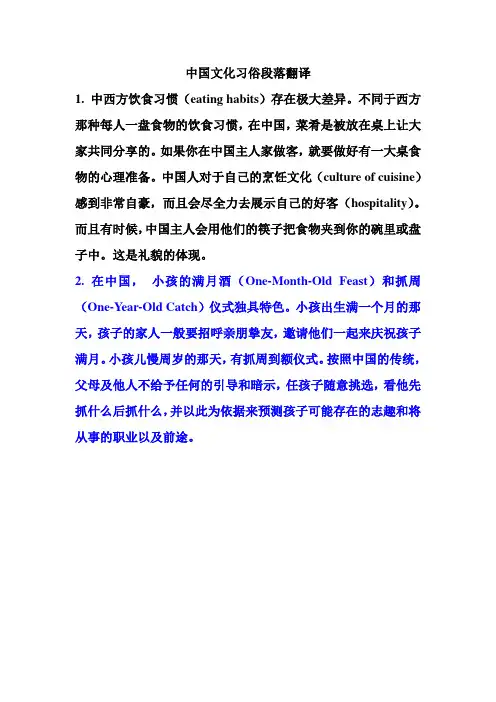
中国文化习俗段落翻译1. 中西方饮食习惯(eating habits)存在极大差异。
不同于西方那种每人一盘食物的饮食习惯,在中国,菜肴是被放在桌上让大家共同分享的。
如果你在中国主人家做客,就要做好有一大桌食物的心理准备。
中国人对于自己的烹饪文化(culture of cuisine)感到非常自豪,而且会尽全力去展示自己的好客(hospitality)。
而且有时候,中国主人会用他们的筷子把食物夹到你的碗里或盘子中。
这是礼貌的体现。
2. 在中国,小孩的满月酒(One-Month-Old Feast)和抓周(One-Year-Old Catch)仪式独具特色。
小孩出生满一个月的那天,孩子的家人一般要招呼亲朋挚友,邀请他们一起来庆祝孩子满月。
小孩儿慢周岁的那天,有抓周到额仪式。
按照中国的传统,父母及他人不给予任何的引导和暗示,任孩子随意挑选,看他先抓什么后抓什么,并以此为依据来预测孩子可能存在的志趣和将从事的职业以及前途。
参考译文1.There are great differences between Chinese and Western eating habits. Unlike the West, where everyone has their own plate of food, in China the dishes are placed on the table and everybody shares. If you are being treated by a Chinese host, be prepared for a table of food. Chinese are very proud of their culture of cuisine and will do their best to show their hospitality. And sometimes the Chinese hosts use their chopsticks to put food in your bowl or plate. This is a sign of politeness.参考译文2: In China, One-Month-Old Feast and One-Year-Old Catch of a baby are of unique Chinese characteristics. On the day when a baby is a month old, the family of the baby will invite their friends and relatives to a ceremony to celebrate the occasion. On the day when a baby is one year old, there is a ceremony of One-Year-Old Catch. According to Chinese traditional custom, nobody will give any instruction or clue to the baby so that it is left free to choose by itself. Watching the baby catch the articles it likes, the family can then make predictions about its potential interest, future career and development.春节贴年画(pasting New Year Print s)的风俗源自于往房子外面的门上贴门神(Door Gods)的传统,随着木质雕刻品(board carvings)的出现,年画包含了更广泛地主题,最出名的就是门神,三大神——福神、薪神、和兽神(three Gods of Blessings, Salary and Longevity),寓意着庄稼丰收、家畜兴旺和庆祝春节。
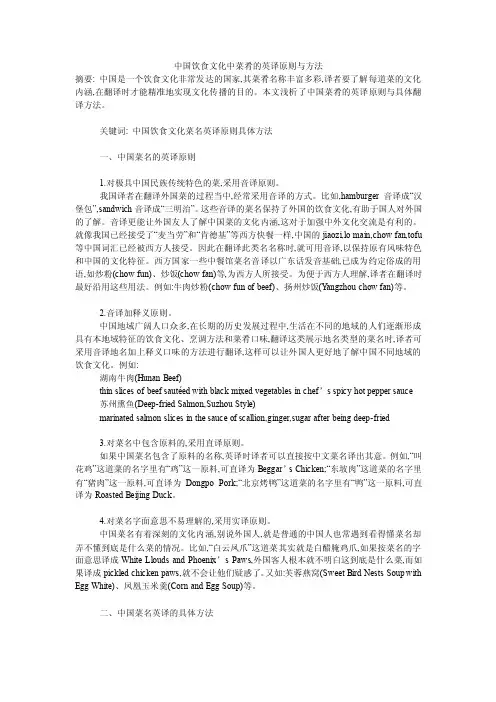
中国饮食文化中菜肴的英译原则与方法摘要: 中国是一个饮食文化非常发达的国家,其菜肴名称丰富多彩,译者要了解每道菜的文化内涵,在翻译时才能精准地实现文化传播的目的。
本文浅析了中国菜肴的英译原则与具体翻译方法。
关键词: 中国饮食文化菜名英译原则具体方法一、中国菜名的英译原则1.对极具中国民族传统特色的菜,采用音译原则。
我国译者在翻译外国菜的过程当中,经常采用音译的方式。
比如,hamburger音译成“汉堡包”,sandwich音译成“三明治”。
这些音译的菜名保持了外国的饮食文化,有助于国人对外国的了解。
音译更能让外国友人了解中国菜的文化内涵,这对于加强中外文化交流是有利的。
就像我国已经接受了“麦当劳”和“肯德基”等西方快餐一样,中国的jiaozi,lo main,chow fan,tofu 等中国词汇已经被西方人接受。
因此在翻译此类名名称时,就可用音译,以保持原有风味特色和中国的文化特征。
西方国家一些中餐馆菜名音译以广东话发音基础,已成为约定俗成的用语,如炒粉(chow fun)、炒饭(chow fan)等,为西方人所接受。
为便于西方人理解,译者在翻译时最好沿用这些用法。
例如:牛肉炒粉(chow fun of beef)、扬州炒饭(Y angzhou chow fan)等。
2.音译加释义原则。
中国地域广阔人口众多,在长期的历史发展过程中,生活在不同的地域的人们逐渐形成具有本地域特征的饮食文化、烹调方法和菜肴口味,翻译这类展示地名类型的菜名时,译者可采用音译地名加上释义口味的方法进行翻译,这样可以让外国人更好地了解中国不同地域的饮食文化。
例如:湖南牛肉(Hunan Beef)thin slices of beef sautéed with black mixed vegetables in chef’s spicy hot pepper sauce 苏州熏鱼(Deep-fried Salmon,Suzhou Style)marinated salmon slices in the sauce of scallion,ginger,sugar after being deep-fried3.对菜名中包含原料的,采用直译原则。
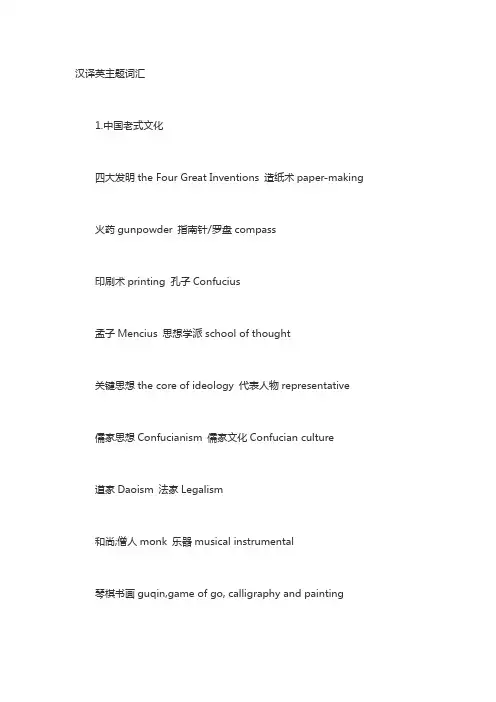
汉译英主题词汇1.中国老式文化四大发明the Four Great Inventions 造纸术paper-making 火药gunpowder 指南针/罗盘compass印刷术printing 孔子Confucius孟子Mencius 思想学派school of thought关键思想the core of ideology 代表人物representative儒家思想Confucianism 儒家文化Confucian culture道家Daoism 法家Legalism和尚;僧人monk 乐器musical instrumental琴棋书画guqin,game of go, calligraphy and painting笛子flute 二胡erhu古筝guzheng 鼓drum琵琶Chinese lute 中国象棋Chinese chess围棋Chinese Go 对弈play chess棋子chess pieces 棋盘chessboard中国书法Chinese calligraphy 甲骨文oracle bone script 文房四宝the four treasures of the study 毛笔brush pen 墨ink stick 砚台inkstone纸paper 笔划stroke四大名著the four masterpieces 中文Chinese character 《西游记》Journey to the West; The Money King《红楼梦》Dream of the Red Chamber; A Dream of Red Mansions 《三国演义》Romance of the Three Kingdoms<<水浒传>>Water Margin; Outlaws of the Mash《诗经》Books of Songs《史记》Records of the Grand Historian;Historical Records唐诗宋词Tang and Song Poetry; Poetry of Tang and Song Danasties 元曲Yuan opera 眀小说Ming novel一般话四声调the four tones of Mandarin Chinese对联couplet 俗语idiom词语phrase 国画Chinese (traditional) painting山水画landscape painting 写意画free sketch painting敦煌壁画Dunhuang frescoes 龙旳形象the image of dragon孔子庙Confucius Temple 黄河the Yellow River长江the Yangtze River 长城the Great Wall故宫the Imperial Palace ; the Forbidden City故宫博物馆The Palace Museum 天安门广场Tiananmen Square胡同hutong 太极拳Tai Chi文武双全be excellent both in the arts of pen and sword孙子兵法Sun Zi’s Art of War ; Master Sun’s Art of War科举制imperial examination system 状元the top scholar; champion 武术Chinese martial arts 古代兵器ancient weapon盔甲suit of armor 剑sword古玩antique 算盘abacus三百六十行all walks of life ; all kinds of jobs 铁饭碗iron bowl 礼节etiquette尊老爱幼respect the old and love the young 礼品馈赠present-giving 民间禁忌folk taboos 丧葬funeral 孝服mourning clothes纸钱ghost money 十二生肖Chinese Zodiac 鼠Rat 牛Ox 鸡Rooster梅花plum blossoms竹子bamboo 松pine 牡丹peony 莲花lotus 莲藕lotus root 中山装Chinese tunic suit中国老式服饰tradition Chinese costume 唐装the Tang suit 民间故事folk tale 寓言fable传说legend凡间human world重要文化遗产major cultural heritage 国宝national treasure 文物cultural relics 高雅艺术high/refined art才子佳人gifted scholars and beautiful ladies享有…….旳声誉enjoy a good/high reputation for被誉为be honored/crowned as 增进友谊enhance friendship 推广中国文化promote Chinese culture文化底蕴cultural deposit 文化事业cultural undertaking文化冲击cultural shock 蓬勃发展flourish文化特性和价值观national identity and value在各地差异很大vary widely from region/place to region/place增进文化旳传播promote the spread of culture丰富多彩be rich and colorful 老式美德traditional virtues尊敬老人respect the elderly 赡养父母support/take care of parents 象征意义symbolic meaning审美观/品味taste for beauty ; aesthetic taste2.中国老式节日春节the Spring Festival 除夕Chinese New Year’s Eve年夜饭the dinner on New Year’s Eve 小年minor Spring Festival 春运Spring Festival travel seasons; Chunyun period买年货do Spring Festival shopping ; buy necessity for Spring Festival 扫尘土sweep the dust 剪窗花do paper-cutting贴春联stick couplets 挂灯笼hang lanterns祭祖offer sacrifices to one’s ancestors 祭祀sacrifices烟花爆竹fireworks and firecrackers 财神the god of wealth压岁钱gift money; lucky money 包饺子make dumplings拜年New Year’s visit 阳历solar calendar天干heavenly stem 地支earthly branch闰年leap year 亲朋好友relatives and friends探亲访友pay a visit to relatives and friends大扫除thoroughly clean the house驱厄运sweep away ill fortune; get rid of bad luck清除劫难ward off evils 年画New Year Picture发红包give money in red envelopes; hand out red envelopes 欢度……the celebration of……; celebrate……. 年糕rice cake 转运have a chance of luck 春卷spring rolls春节联欢晚会Spring Festival Gala 祝愿短信blessing message 元宵节the Lantern Festival 元宵sweet dumplings扭秧歌do the Yangko Dance 舞龙dragon dance舞狮lion dance 灯谜lantern riddles龙昂首Dragon Heads-raising Day 祈雨pray for rain丰收good harvest 清明节Tomb Sweeping Day雨水rainwater 春耕the Spring ploughing扫墓attend/sweep tomb; clean the grave祭品sacrifices; sacrifice offerings 踏青have an outgoing in Spring 端午节Dragon Boats Festival 粽子Zongzi; glutinous rice pudding 赛龙舟dragon boats racing 雄黄酒realgar wine七夕Double Seventh Festival 梳妆dress and make up牛郎Cowherd 织女Weaver Maid喜鹊桥the magpie bridge 中元节/鬼节Ghost Festival河灯water lantern 中秋节Mid-autumn Festival团圆饭family reunion dinner 花灯colorful lantern月圆夜full moon 赏月enjoy the moon吃月饼have moon cake 思想be homesick重阳节Double Ninth Festival 重阳糕double ninth cake赏菊enjoy chrysanthemums 菊花酒chrysanthemum wine 寒食节Cold Food Festival 冷食cold food禁烟smoking ban; not allow to make fire 斗鸡cockfight 蹴鞠kickball; cuju 荡秋千play on a swing拔河push-and-pull; tug of war 腊八节the Laba Festival 腊八粥Laba rice porridge 腊八面Laba noodle3.中国饮食文化中国菜Chinese cuisine; Chinese food 粤菜Canton cuisine 炒stir-fry 煎fry炸deep-fry 烩/焖/炖stew蒸steam 烘焙bake切条cut to strips 切丁dice切碎mince 磨碎grind特色食品specialty 红茶black tea绿茶green tea 火锅hotpot熊掌bear paw 豆浆soybean milk馒头steamed buns 花卷steamed twisted rolls包子steamed stuffed buns; Baozi 北京烤鸭Beijing Roast Duck 4.中国老式手工艺老式工艺品traditional handicraft 绣花鞋embroidered shoes优秀民间艺术品outgoing folk arts 中国瓷器Chinese ceramics 唐三彩Tricolor-glazed Pottery of the T ang Dynasty彩陶painted pottery 材质各异various materials陶器pottery; earthenware 质地坚硬hard texture青铜器bronze ware 造型生动vivid figure雕刻carving 色彩丰富rich color玉雕jade carving 风格独特characteristic/unique style蜡染wax printing 中国织绣Chinese silk embroideries泥人clay figure 中国结Chinese knot刺绣embroidery 绣球embroidered ball5.中国演出艺术脸谱facial makeup 正面角色positive role说学逗唱speaking, imitating, teasing and singing木偶戏puppet show 说书story-telling皮影戏shadow play 杂技acrobatics客家山歌Hakka hill song 历史人物historical figure四大文明古国之一one of the four ancient civilizations 人类文明史the history of human civilization中国古代史ancient Chinese History中国近现代史modern history of China历史遗留问题a question left over from history/the past 源远流长/历史悠久with/have a long history繁华盛世a time of prosperity 古都ancient capital华夏之祖ancestors of Chinese nation 发祥地birthplace 封建朝代feudal dynasty 远古时代ancient times兴起于……,昌盛于……..emerge in……and prosper in…..原始社会primitive society 战国the Warring States春秋时期the Spring and Autumn Period封建社会feudal society 印/玺seal/stamp皇妃imperial concubine 太后empress dowager诸侯Prince/duck under an emperor 宰相prime minister 士大夫scholar-officials 太监eunuch侍卫bodyguard 将军general6.旅游交通旅游景点tourist scenes 避暑胜地summer resort森林公园forest park 人文景观human landscape自然景观natural scenery 建筑architecture壮丽河山magnificent scenery 皇家园林royal garden古典山水园林classical landscape garden钟楼bell tower 鼓楼drum tower牌坊memorial archway 兵马俑Terracotta Warriors天坛the Temple of Heaven 保留最完好旳best-preserved 原址original site 国家博物馆national museum中外游客tourist from home and aboard7.地理环境版图广阔have a vast territory 省会provincial capital水域面积water area 高原plateau三面环山be surrounded by mountains on three side全长……公里stretch for…km/kilometers 植物园botanical garden 淡水湖freshwater lake 沿海港口coastal port8.医疗健康诊断diagnosis(n); diagnose(v) 偏方folk prescription祖传秘方secret prescription handed down from one’s ancestors 中医Traditional Chinese Medicine(TCM)救死扶伤heal the sick and rescue the dying望闻问切observing, listening, inquiring, pulse-taking 肥胖症obesity 草药herbal therapy食疗food therapy 延缓衰老slow down aging。
中西饮食文化差异略谈中西方饮食文化差异餐饮产品由于地域特征、气侯环境、风俗习惯等因素的影响,会出现在原料、口味、烹调方法、饮食习惯上的不同程度的差异。
正是因为这些差异,餐饮产品具有了强烈的地域性。
中西文化之间的差异造就了中西饮食文化的差异,而这种差异来自中西方不同的思维方式和处世哲学。
中国人注重“天人合一”,西方人注重“以人为本”。
这里简要从下面三个方面谈谈中西方饮食文化的差异。
一、两种不同的饮食观念对比注重“味”的中国饮食,西方是一种理性饮食观念。
不论食物的色、香、味、形如何,而营养一定要得到保证,讲究一天要摄取多少热量、维生素、蛋白质等等。
即便口味千篇一律,也一定要吃下去——因为有营养。
这一饮食观念同西方整个哲学体系是相适应的。
形而上学是西方哲学的主要特点。
西方哲学所研究的对象为事物之理,事物之理常为形上学理,形上学理互相连贯,便结成形上哲学。
这一哲学给西方文化带来生机,使之在自然科学上、心理学上、方法论上实现了突飞猛进的发展。
但在另一些方面,这种哲学主张大大地起了阻碍作用,如饮食文化。
在宴席上,可以讲究餐具,讲究用料,讲究服务,讲究菜之原料的形、色方面的搭配;但不管怎么豪华高档,从洛杉矶到纽约,牛排都只有一种味道,无艺术可言。
作为菜肴,鸡就是鸡,牛排就是牛排,纵然有搭配,那也是在盘中进行的,一盘“法式羊排”,一边放土豆泥,旁倚羊排,另一边配煮青豆,加几片番茄便成。
色彩上对比鲜明,但在滋味上各种原料互不相干、调和,各是各的味,简单明了。
中国人是很重视“吃”的,“民以食为天”这句谚语就说明我们把吃看得与天一样重要。
由于我们这个民族几千年来都处于低下的生产力水平,人们总是吃不饱,所以才会有一种独特的把吃看得重于一切的饮食文化,我想,这大概是出于一种生存需要吧。
如果一种文化把吃看成首要的事,那么就会出现两种现象:一方面会把这种吃的功能发挥到极致,不仅维持生存,也利用它维持健康,这也就是”药补不如食补”的文化基础;另一方面,对吃的过份重视,会使人推崇对美味的追求。
论中国菜肴的命名文化与翻译中华文明有历史悠久,餐饮文化博大精深。
中国菜以其色、香、味、形而文明,中国美食的品尝已成为中国旅游业的重要组成部分。
而菜肴的名字也是饮食文化的重要组成部分,并且对中国菜肴名字的翻译也是传播信息和文化的一种手段。
中国菜肴名字的翻译可以使外国人更好地了解中国饮食文化,进一步促进文化交流。
本文在对中国菜肴命名特点与文化的研究基础上,提出了中国菜肴名称英译的原则和方法。
总之,如果一个译者想正确地翻译中国的菜名,那么就应该更多地了解中国的饮食文化。
译者在翻译中国的菜名时必须灵活,以便更好地向外国友人介绍中国的食品和文化。
标签:直译;释译;归化翻译中国作为四大世界文明古国之一,有着悠久的历史和文化。
其中就包含了美食文化,丰饶的物产为美食的发展提供了基础。
而美食所体现的是一个民族的素养,人文地理的画卷,美食也因为有了渊源和传说典故更彰显文化。
中国菜的菜名,既有实用性又有艺术性,反映了中国饮食文化的历史,也折射出国人的风俗习惯、思维方式及价值观念,有浓郁的地域性文化特色。
随着全球化的发展,地球也成了地球村,人与人之间的交往也越来越广泛,国与国的交流也越来越频繁,文化的交流已是大势所趋。
便利的交通,让跨国的往来成为简单事情。
越来越多的外国友人不远千里来到中国,观古国风采,嗅古国气息,品古国佳肴。
随之出现的问题就是文化之间的碰撞与交流,为了更好地交流彼此文化,更好的将中华文化发扬光大,翻译的作用就尤为重要了。
作为信息沟通的一种手段,翻译越来越深入日常。
一个好的翻译,可以让外国友人更加深刻的了解中国的文化,可以更好的宣传中国的文明。
因此准确形象的把中国菜名译成英语,对传播我国饮食文化起着重要的作用。
但想要准确的对中国菜肴的名字进行翻译,就要先了解中国菜肴名字的命名特点。
一、中国菜肴的命名特点中国菜肴的取名多姿多彩,有时用写实的手法,有时也用浪漫主义的笔调;不但有包含政治、历史、地理的背景因素的,也有包含了民俗、神话、传说等内涵的。
中国饮食文化的翻译技巧和策略如今国际性交流越来越频繁,我国的传统文化在交流中逐渐流向国际,受到很多外国朋友的青睐,但如何通过翻译的形式,让外国朋友了解到我国传统文化的内涵,成为我国关注的重要问题。
其中中国饮食文化作为中国传统文化的独特分支,其以独特的口味和丰富的种类受到广泛的关注。
要使对中国饮食文化感兴趣的外国朋友更进一步了解中国传统文化,则需要在翻译中体现中国饮食文化的内涵。
一、中国饮食文化翻译及中西方饮食文化差异文化是一种可以体现和传承某一国家和民族的历史、风情、习俗、艺术、思维、价值观念等,是一种可以进行交流的意识形态。
宽泛而言,人类社会与文化关系非常紧密,几乎所有的社会活动、人类行为等都与文化相关。
其中饮食文化应当作为文化的重要组成部分,我国饮食文化博大精深、源远流传,其存在深厚的内涵和价值。
随着我国经济的进步和科技的发展,如今我国与其他国家之间的交流越来越普遍,越来越多的外国友人被中国特色文化所吸引,其中中国饮食文化以期独特性和丰富性,受到广大外国朋友的关注,中国饮食也逐渐流传到国外。
如何让外国友人在了解和品尝中国美食时,并感受到中国饮食文化的内涵,成为翻译界考虑的问题。
在进行中国饮食文化翻译时,如果仅仅采用简单的字面翻译方法,则会让外国友人无法了解到中国饮食文化的内涵。
中国饮食文化作为中国民族文化的重要组成部分,良好的翻译应当展现出饮食文化的内涵。
由于中国与其他国家的历史、地理、生活习惯、习俗、思维及价值观念等都存在一定的差别,导致中国饮食文化与其他国家的饮食文化也较差较大的差异。
很多翻译者在进行饮食文化的翻译时,由于各种因素导致中国饮食翻译后,外国友人难以理解,甚至会误解为另一种东西。
如中国和西方国家存在饮食文化差异,中国人民认为饮食在人们的生活中具有重要的作用,其不仅使为了填饱肚子,还是促进人与人交流的主要条件。
但西方国家则认为饮食单纯只起到营养品的作用,并没有赋予饮食更加深厚的内涵。